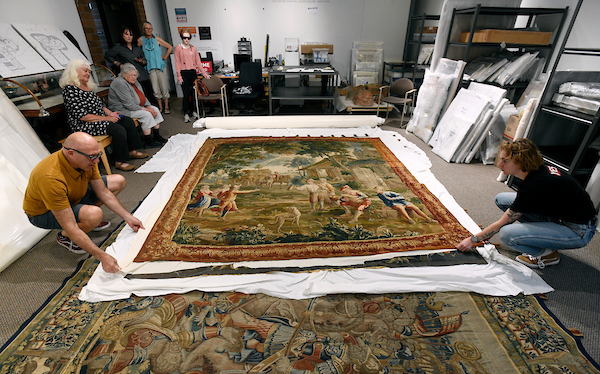Historical Threads: Missoula Weavers Guild Invited to Study UM’s European Tapestries
MISSOULA – For members of the Missoula Weavers Guild, it was an invitation to see, first-hand, centuries-old tapestries stored for decades on the University of Montana campus.
For staff at the Montana Museum of Art and Culture, it was an opportunity to gather the member’s insights and assessments on the pieces’ condition, with the goal of displaying one work in the inaugural exhibition of UM’s new museum, opening this fall during Homecoming Week.
For both, it was chance to admire, up close – sometimes on hands and knees – large works of art that once graced the walls of Europe’s grand palaces, as much for ornament as a means to keep spacious rooms warm.
“I don’t know of anywhere else in this part of the country with tapestries as rare and valuable as these pieces,” said MMAC Director H. Rafael Chacón during the Guild’s visit in June.
“It’s remarkable that we have these works here in Missoula and indicative of the quality of UM’s Permanent Collection of art,” he added.
The University purchased the tapestries, along with a trove of other pieces, in the late 50’s with funds donated by East Coast businesswoman and philanthropist Josephine Bay. Made primarily of vegetable-dyed wool, they date back to the 16th century and were woven by Flemish artisans, considered then and now masters of this intricate and time-consuming art form.
“I was really blown away by how well preserved they are,” said Jackie Boshka, program director for the Guild, founded 75 years ago and one of the oldest in the country. “As a weaver it’s difficult to imagine the magnitude of work that went into tapestries this large and how many of them were made at the time.”
During their visit the members closely examined three tapestries under consideration for the museum’s grand opening. Joining them was Elizabeth Tritthart of Historic Weaving of Butte who provided her insights on the works’ condition.
The first tapestry, carefully unrolled on the floor, was a Renaissance work called “Deeds and Triumphs of Scipio from the Second Punic Wars.” At 10 by 15 feet, it is the largest of the pieces.
Riotous in design and deeply hued, it portrays two ancient armies intertwined in battle, replete with rushing horseman and marching spearmen. Framing the battle scene is a border depicting beasts, cornucopias, flowers, sphinxes, satyrs, mythical gods and fanciful architectural designs.
“It was really fascinating to learn more about the important role these tapestries played in story-telling at the time,” said Guild Communication Director Jennie Meinershagen, “and as a weaver to see how well the colors held up was amazing.”
Embedded among the tapestry’s panels though were noticeable separations in the weave – signs of wear that can come with centuries of age and thousands of miles in travels.
“This was the tapestry we had hoped to display for the opening, but it is just too fragile so we are going to wait until we can hire conservators to repair it,” said Chacón, adding that the second tapestry, a Gothic work called “Judith with the Head of Holofernes,” also will wait based on the group’s input on needed conservation work.

Chacon and MFA candidate Dagny Walton, right, unroll an 18th-century Brussels tapestry called “Le Joueur de Cornemuse” (or “The Bagpipe Player”), which will be on display for the opening of the new MMAC building.
Instead, the museum will display a smaller Brussels tapestry called “Le Joueur de Cornemuse” (or “The Bagpipe Player”), which was woven in the early- to mid-18th century and depicts a bagpiper with a group of dancers in a busy village. Colored in rich greens, reds and blues, and ornate in design, the Baroque work is in a much better condition to display.
“It’s of such high quality and in relatively stable condition that it can go on view in September, at least for a few months,” Chacón said. “It also will eventually need minor conservation work, but I would like Montanans to experience this masterpiece at the opening. We are not shy about exhibiting works of art as they are.”
This is not the first time the Weavers Guild has lent their expertise to the University’s art collection. They’ve spent the past several years cataloguing weavings by UM chemistry professor William G. Bateman, who served on faculty 1912 to 1937. Bateman developed innovative patterns for his weaving, based on mathematical principles, that still influence the craft today.
“He left a portion of his collection to UM,” Boshka said. “We did analysis of the works, and they are now being photographed.”
“We owe an enormous debt to the Guild for countless hours dedicated to researching this unique collection and maintaining the legacy of Dr. Bateman,” Chacón added. “This collection was one man’s passion, almost his obsession. It’s good to see that same level of devotion in the members of the Guild.”
Later this summer Chacón will turn again to Guild members for help displaying “Le Joueur de Cornemuse” for the museum opening in September. They plan to remove the tapestry’s existing hanging rings as Tritthart suggested, and create a new, safer system for displaying it. Researching how to best conserve all three tapestries will follow.
The MMAC’s ability to tap into the deep talents of Montana-based artists and specialists, Chacón said, makes this work particularly rewarding.
“We have a great collection and a highly skilled and knowledgeable community,” he said, “When they come together, it really shows the magic of this institution.”
Editor's note: The new 17,000 square-foot MMAC building will open to the public in September. The privately funded project is made possible by the generosity of many donors, including a contribution of $12.5 million from longtime UM donors Patt and Terry Payne.
###
Contact: H. Rafael Chacón, Suzanne and Bruce Crocker Director of the MMAC, 406-243-2019, rafael.chacon@mso.umt.edu.